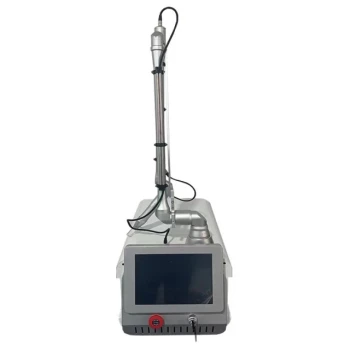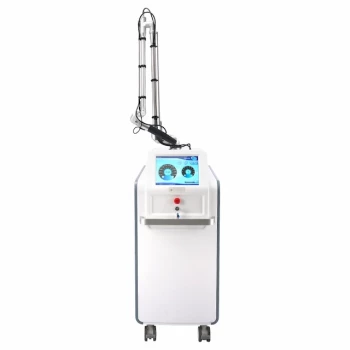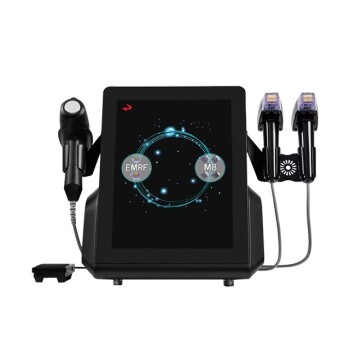A fractional CO2 laser is a powerful skin resurfacing tool used to treat significant signs of skin damage, including deep wrinkles and prominent scars. It works by precisely removing microscopic columns of skin, which triggers a powerful natural healing response and stimulates the production of new collagen, resulting in smoother, firmer, and more youthful-looking skin.
The fractional CO2 laser is one of the most effective treatments for dramatic skin rejuvenation, but its power comes with a significant trade-off. Achieving its transformative results requires a considerable recovery period, often lasting up to two weeks.

How a Fractional CO2 Laser Achieves Results
The effectiveness of the fractional CO2 laser lies in its unique method of interacting with the skin. It is an ablative laser, meaning it works by vaporizing tissue, but it does so in a "fractionated" pattern.
The Principle of Fractional Ablation
Instead of removing the entire surface layer of skin, a fractional laser creates a grid of microscopic treatment zones, like tiny perforations. It removes minuscule columns of skin tissue while leaving the surrounding tissue completely intact.
Stimulating a Healing Response
These micro-injuries act as a powerful signal to the body's repair systems. The untouched skin surrounding each treated column serves as a reservoir of healthy cells that accelerate healing across the entire area.
Boosting Collagen Production
The core of the treatment's success is the stimulation of collagen, the protein that gives skin its structure and firmness. The healing process initiates a long-term collagen remodeling cycle, leading to results that continue to improve for months after the procedure.
Primary Conditions Treated by CO2 Lasers
The CO2 laser's ability to remodel tissue makes it highly effective for a range of challenging skin concerns.
Deep Wrinkles and Fine Lines
This is a primary application for the technology. The laser is exceptionally effective at softening deep-set wrinkles, particularly those around the eyes ("crow's feet") and mouth.
Scars (Acne, Surgical, and Traumatic)
By breaking down old, disorganized scar tissue and stimulating the growth of new, healthy collagen, the laser can dramatically improve the texture and appearance of various types of scars.
Benign Skin Growths
Dermatologists can use the precision of the CO2 laser to remove unwanted benign growths such as warts, certain types of birthmarks, and other skin lesions.
Rhinophyma (Enlarged Nasal Glands)
The laser can be used to carefully reshape and reduce enlarged oil glands on the nose, a condition known as rhinophyma, restoring a more normal contour.
Understanding the Trade-off: Downtime and Recovery
The power of an ablative laser is directly linked to its required recovery time. This is not a "lunchtime" procedure, and understanding the healing process is critical.
The Initial Recovery Window
The most intensive phase of healing occurs within the first two weeks. During this time, you can expect significant redness, swelling, and peeling as the old, damaged skin gives way to the new layer underneath.
Why This Downtime is Necessary
This recovery period is not an unfortunate side effect; it is the essential mechanism of action. The visible healing on the surface is a direct reflection of the intense collagen-building activity happening in the deeper layers of the skin.
Long-Term Healing
While social downtime may be around two weeks, some residual redness can persist for several weeks longer. The final results are not immediate, as collagen remodeling continues for three to six months following the treatment.
Making the Right Choice for Your Goal
Deciding if a fractional CO2 laser is right for you depends entirely on balancing your goals with your tolerance for downtime.
- If your primary focus is significant wrinkle reduction or deep scar revision: The CO2 laser is an industry gold standard and one of the most effective options available, provided you can commit to the recovery period.
- If your primary focus is mild texture improvement with minimal downtime: You should explore less aggressive treatments first, such as non-ablative lasers, microneedling, or a series of chemical peels.
- If your primary focus is removing a specific benign growth: The CO2 laser is an excellent tool for this, but a consultation with a board-certified dermatologist is required to ensure it is the correct approach for your specific lesion.
Ultimately, the fractional CO2 laser is a tool for profound skin transformation, best suited for individuals who prioritize dramatic, lasting results over a quick and easy recovery.
Summary Table:
| Key Feature | Description |
|---|---|
| Mechanism | Fractional ablation creating micro-injuries to stimulate healing. |
| Primary Uses | Deep wrinkles, acne/surgical scars, benign skin growths, rhinophyma. |
| Key Benefit | Significant collagen production for long-term skin tightening and rejuvenation. |
| Downtime | Intensive recovery period of up to 2 weeks, with full results over 3-6 months. |
Ready to offer transformative skin rejuvenation to your clients?
BELIS specializes in professional medical aesthetic equipment, providing powerful and reliable fractional CO2 laser systems to medical aesthetics clinics and premium beauty salons. Enhance your service portfolio with industry-leading technology that delivers dramatic, lasting results for your clients.
Contact our experts today to find the perfect CO2 laser solution for your business.
Visual Guide

Related Products
- Fractional CO2 Laser Machine for Skin Treatment
- Fractional CO2 Laser Machine for Skin Treatment
- Hydrofacial Machine with Facial Skin Analyzer and Skin Tester
- Pico Laser Tattoo Removal Machine Picosure Picosecond Laser Machine
- Hydrafacial Machine Facial Clean Face and Skin Care Machine
People Also Ask
- What is a fractional CO2 laser machine used for? A Guide to Advanced Skin Resurfacing
- Why am I not seeing results after a CO2 laser? Your Patience is the Key to Long-Term Skin Rejuvenation
- Is CO2 laser for all skin types? A Critical Guide to Skin Type Safety and Risks
- How does fractional CO2 laser work? The Science Behind Powerful Skin Renewal
- What will my face look like after a CO2 laser? Your Complete Recovery Timeline



















